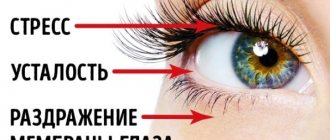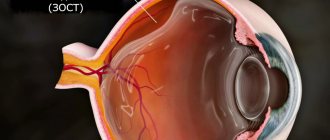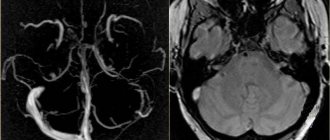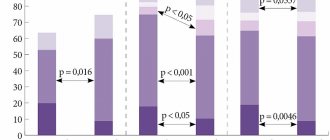Publication date: August 21, 2020
Sometimes, when you have to change your body position, darkening occurs in your eyes. And this is usually associated with various pathologies. Although this phenomenon is not always a danger signal. The eyes also become dark in a healthy person when there is overwork caused by heavy physical exertion or a stressful condition. Often the symptom of darkening in the eyes occurs when standing up. It may recur regularly or may be a one-time occurrence. Darkening in the eyes that appears sporadically does not indicate visual impairment. This is only a short-term deterioration in the perception of the environment. And the exact cause of darkening in the eyes can be determined by a doctor at a medical center by conducting diagnostic examinations.
Blood pressure problems
Dizziness, quite severe, often occurs in people with low blood pressure. Their blood pressure sometimes drops below 100/60 mmHg. And it leads to severe discomfort in the body: tinnitus, dark spots in the eyes and severe headaches. This condition often leads to fainting. Low blood pressure is often observed in pregnant women and teenage children. Therefore, if a person is aware of his low blood pressure, then he does not need to make sudden movements.
What should you do if your vision gets dark after you get up?
Often, as already mentioned, this condition does not last long. To get rid of it faster, you can resort to some remedies. For example, drink strong black sweet tea. It should normalize blood pressure and bring you back to normal. Also, if possible, lie down and raise your legs up. This will allow the blood to distribute evenly throughout the body. If lying down is not possible, then sit down and rest your head on your knees. You can also get rid of darkening when standing up with the help of medications, but before using them you should consult a doctor and find out the cause of this condition. If you are often subject to darkening of your vision, try not to drive at such times, or work with traumatic objects. As a preventive measure, engage in physical exercise, watch your diet and take vitamins.
Vegetative-vascular dystonia
This disease often occurs in adolescents. It is associated with insufficient maturity of the endocrine and nervous systems. Manifest in one-time attacks or have a chronic course.
The resulting darkness in the eyes is characteristic of hypotensive dystonia. During the next attack, a person’s pulse quickens and his vision darkens. Such patients complain that the chest is heavy, there is not enough air, and there is weakness with headache. Symptoms of vegetative-vascular dystonia include cold extremities and frequent fainting.
Dystonia is caused by exhausting physical activity, vitamin deficiencies, and poor nutrition among middle-aged people.
Darkening in the eyes of a teenager (causes, treatment, prevention)
In recent years, teenagers have increasingly complained to parents and doctors about periodic darkening of the eyes. This condition is quite common, and there is no cause for concern if it appears extremely rarely and for a short time. But it happens that children suffer from pre-fainting conditions, when their vision suddenly and often becomes dark for a long time. In this case, you need to contact a neurologist as soon as possible.
Let’s take a closer look: why can a teenager’s vision get dark?
The most common cause of this condition is autonomic dysfunction, which most often occurs in the form of neurocircular dystonia. In general, the human autonomic nervous system is responsible for such important functions as preserving and maintaining the constancy of the internal environment of the body. This constancy is ensured by the vital systems of the body: the cardiovascular, respiratory, endocrine systems and their main indicators (blood pressure, heart rate and respiration, body temperature, sweating, metabolic rate).
If we talk in general about autonomic dysfunction, then it is a pathological condition of the body, characterized by a symptom complex of disorders of psychoemotional, sensorimotor and autonomic activity, associated with suprasegmental and segmental disorders of the autonomic regulation of the activities of various organs and systems. That is, this is a disruption of the normal activity of the autonomic nervous system, which leads to a “failure” in the functioning of the internal organs and systems of the body.
The features of the disease neurocircular dystonia are determined by the contradictions between the rapid growth of the body and the possibilities of providing this growth with blood vessels. A lag in vascular support often results in pre-fainting conditions - a direct consequence of fluctuations in blood pressure - which, in fact, causes darkening in the eyes of adolescents.
The list of complaints with neurocircular dystonia is varied and, along with darkening of the eyes, may include:
- Pain in the heart area (stabbing and short-term or aching and long-lasting);
- Headache;
- Heart failure;
- Feeling of lack of air;
- Instability of pulse and blood pressure;
- Feeling of fear, sweating, dizziness, weakness.
It is worth noting that 80-90% of children with autonomic dysfunction are born as a result of fast, rapid, less often protracted labor, using various types of obstetric assistance. That is, even the most minor birth injuries can be accompanied by damage to the cervical spine and can have a negative impact already in adulthood.
Also, among the main reasons why a teenager’s vision becomes dark is often the development of degenerative processes in the cervical spine. The most common and dangerous such process is juvenile osteochondrosis.
Pathology of the cervical spine (functional instability and juvenile osteochondrosis of the cervical spine) brings a lot of unpleasant sensations, which is associated with the involvement of nearby vessels and nerve trunks in the pathological process. Therefore, next to darkening of the eyes, the first symptoms include pain in the head, a crunch in the neck, dizziness and fatigue. The child may also experience fainting or pain in the neck, shoulders or arms.
Signs of the development of functional instability and juvenile osteochondrosis of the cervical spine in adolescents may be impaired coordination of movements, hearing or vision impairment. These symptoms indicate a deficiency of molecular oxygen in the brain, due to compression of the vertebral artery by a displaced cervical vertebra or disc.
Other, but no less important, reasons why a child’s vision may periodically become dark include:
- Severe emotional or physical fatigue;
- Excessive sensitivity to any changes in the environment and internal state (high air temperature, stuffy room, emotional stress, fear);
- Low blood pressure (complaint: “my vision gets dark when I get out of bed in the morning”)
- Poor nutrition, loss of energy;
- Diabetes;
- Some infectious diseases.
Therefore, we strongly recommend that you do not delay your visit to the doctor, because the sooner you discover the cause of the disease and begin treatment, the better the result you will achieve! You can make an appointment with a pediatric neurologist by calling the children's department or calling the contact center (044) 238-22-31.
First aid
Symptoms of darkening of the eyes appear very quickly, so their manifestation can be noticed and the negative consequences of this type of incident can be minimized, including strong falls, bumping into surrounding objects, and loss of balance. If such symptoms occur, the best solution is to sit or lie down, provide fresh air, drink cold, clean water or sweet tea.
If darkening of the eyes is accompanied by fainting, then it is recommended to lay the person on his side, in order to avoid swallowing the tongue when relaxing, it is better not to raise the head, so as not to interfere with the flow of blood to the brain. It is also permissible to use ammonia or splashes of cold water to try to revive the person.
Causes
Darkening of the eyes can be a consequence of two main fundamental reasons, the first of which is the lack of oxygen and various nutrients that should have reached the brain. The second may be pathology or disorders of the visual system.
Darkening of the eyes is often the first symptom, followed by dizziness or fainting.
More often than not, most fainting and darkening of the eyes that are common in everyday life are low-risk and do not indicate vital health problems or damage. But sometimes such phenomena indicate the development of quite serious processes in the human body and require urgent contact with doctors, where, after a thorough examination and possible confirmation of negative changes in the body, a serious course of treatment can be prescribed. However, it is worth emphasizing that the treatment will not be the consequence, which is darkening in the eyes, but the root causes that caused this failure.
Content:
- Causes
- Safe causes of darkening of the eyes
- Darkening of the eyes from disease
- Characteristics of diseases
- Local visual problems
- First aid
- Diagnosing the problem
- Preventing dark eyes
Local visual problems
Do not forget that sometimes the cause of darkening in the eyes can be problems that are associated only with the visual analyzer itself. Among them are the following:
- visual field defects;
- violations of the integrity of the optic tract;
- optic nerve diseases.
Darkening is caused by pathological loss of visual fields. A sudden movement in this case, or a sharp turn of the head can cause such a reaction in the eye.
Patients with glaucoma and people with farsightedness and myopia also complain of similar problems after prolonged visual strain.
Problems can arise when the signal from the eyes to the brain is disrupted, which occurs when the optic nerve or optic tract becomes spasmed or paralyzed.
To determine an accurate diagnosis that will reliably show the source of the problem and possible ways to eliminate it, a comprehensive ophthalmological examination will be required, including ophthalmoscopy, refractometry and several other manipulations that the doctor deems necessary in a particular individual case.
Diagnosing the problem
If you suspect such a problem, you should immediately consult a therapist and ophthalmologist. If this symptom is not a consequence of overwork, then a series of studies are prescribed.
These examination methods include the following four main types:
- MRI of the brain.
- MRI of the orbits.
- Computerized perimeter visual field testing, which can detect scotomas.
- MRI of the vessels of the neck and head, which diagnoses disorders in the circulatory system.
It is worth remembering that after visiting a doctor with a similar problem, a patient complaining of darkening in the eyes must be prepared for the fact that he will have to clearly answer many questions of interest to the doctor. It is necessary to describe in as much detail as possible what exactly the nature and signs of the symptoms are, how often the most serious of them or maximum darkening occur, whether the person has previously experienced injuries associated with damage to the skull and brain, and whether there have been certain diseases recently. Only after listening to a detailed answer from the patient, the doctor can prescribe the necessary examination with research from one or another specialist, and subsequently save the person from this serious problem.
Folk remedies for the treatment of hypotension
The choice of medications to treat hypotension is the responsibility of the physician. In some cases, treatment can be carried out without the use of medications. Hypotension can be normalized with the help of pharmaceutical tinctures and medicinal herbs. The most effective for hypotension is Schisandra tincture. It should be consumed twice a day - morning and evening, half an hour before meals. The optimal dose for oral administration is 20–30 drops.
Another proven folk remedy for improving hypotension is ginseng tincture. It is taken for 20 days, twice a day, 5-20 drops, best before meals - in the morning and in the middle of the day.











